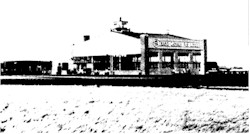|
|
|
One of our most recurring themes at The NetLetter is how the movement of goods and services have shaped (and continue to shape) the aviation industry on Canada. The Lethbridge article chronicles the important role of mail service in the 1930's and how it was certainty a catalyst in the creation of Trans-Canada Air Lines. Quoting from the article: "On April 10, 1937, Trans-Canada Air Lines (TCA) was created as a crown corporation with a mandate to provide transcontinental air passenger, air mail, and air freight service. Why was a crown corporation created de novo when a private sector firm, Canadian Airways (precursor to Canadian Pacific Airlines and later Canadian Airlines International), was already in existence as Canada's largest air carrier? The decision has been variously attributed to "a fit of absence of mind," the mutual distrust between James W. Richardson, founder of Canadian Airways, and CD. Howe, Minister of the Department of Transport, and by the unwillingness of Canadian Airways to participate in the new airline without having much influence in its management. Trans-Canada Air Lines was created as a wholly-owned subsidiary of Canadian National Railways." |
|
For the first nine years of trans-continental airline service, 1939-1948, Lethbridge was western Canada's principal airline hub. The city was ideally situated to fulfill this function due to its location on the southerly route of the 'Trans-Canada Airway' and the limited operational ceiling of the unpressurized Lockheed aircraft then in use. In 1938 TCA built the hangar pictured here at Kenyon Field (now Lethbridge Airport (YQL). The hangar is still standing today (pictured in this issue's header) and has (appropriately) been declared a heritage site. It is well worth the time to open the links below for a couple of great reads on this historic era. |
|
Hangars and History: Lethbridge Airport history: |
|
Click the image below for a larger view of the Trans-Canada Air Lines route map in 1939.. |
 |


